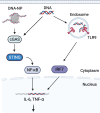DNA corona on nanoparticles leads to an enhanced immunostimulatory effect with implications for autoimmune diseases
- PMID: 38442162
- PMCID: PMC10945806
- DOI: 10.1073/pnas.2319634121
DNA corona on nanoparticles leads to an enhanced immunostimulatory effect with implications for autoimmune diseases
Abstract
Autoimmune and inflammatory diseases are highly complex, limiting treatment and the development of new therapies. Recent work has shown that cell-free DNA bound to biological microparticles is linked to systemic lupus erythematosus, a prototypic autoimmune disease. However, the heterogeneity and technical challenges associated with the study of biological particles have hindered a mechanistic understanding of their role. Our goal was to develop a well-controlled DNA-particle model system to understand how DNA-particle complexes affect cells. We first characterized the adsorption of DNA on the surface of polystyrene nanoparticles (200 nm and 2 µm) using transmission electron microscopy, dynamic light scattering, and colorimetric DNA concentration assays. We found that DNA adsorbed on the surface of nanoparticles was resistant to degradation by DNase 1. Macrophage cells incubated with the DNA-nanoparticle complexes had increased production of pro-inflammatory cytokines tumor necrosis factor alpha (TNF-α) and interleukin 6 (IL-6). We probed two intracellular DNA sensing pathways, toll-like receptor 9 (TLR9) and cyclic GMP-AMP synthase (cGAS)-stimulator of interferon genes (STING), to determine how cells sense the DNA-nanoparticle complexes. We found that the cGAS-STING pathway is the primary route for the interaction between DNA-nanoparticles and macrophages. These studies provide a molecular and cellular-level understanding of DNA-nanoparticle-macrophage interactions. In addition, this work provides the mechanistic information necessary for future in vivo experiments to elucidate the role of DNA-particle interactions in autoimmune diseases, providing a unique experimental framework to develop novel therapeutic approaches.
Keywords: DNA; autoimmune disease; corona; inflammation; nanoscience.
Conflict of interest statement
Competing interests statement:The authors declare no competing interest.
Figures










Similar articles
-
Engineering and Delivery of cGAS-STING Immunomodulators for the Immunotherapy of Cancer and Autoimmune Diseases.Acc Chem Res. 2023 Nov 7;56(21):2933-2943. doi: 10.1021/acs.accounts.3c00394. Epub 2023 Oct 6. Acc Chem Res. 2023. PMID: 37802125 Free PMC article.
-
Association of Abnormal Elevations in IFIT3 With Overactive Cyclic GMP-AMP Synthase/Stimulator of Interferon Genes Signaling in Human Systemic Lupus Erythematosus Monocytes.Arthritis Rheumatol. 2018 Dec;70(12):2036-2045. doi: 10.1002/art.40576. Epub 2018 Oct 14. Arthritis Rheumatol. 2018. PMID: 29806091
-
Significance of the cGAS-STING Pathway in Health and Disease.Int J Mol Sci. 2023 Aug 28;24(17):13316. doi: 10.3390/ijms241713316. Int J Mol Sci. 2023. PMID: 37686127 Free PMC article. Review.
-
The cGAS-STING signaling in cardiovascular and metabolic diseases: Future novel target option for pharmacotherapy.Acta Pharm Sin B. 2022 Jan;12(1):50-75. doi: 10.1016/j.apsb.2021.05.011. Epub 2021 May 20. Acta Pharm Sin B. 2022. PMID: 35127372 Free PMC article. Review.
-
Emerging role of the cGAS-STING signaling pathway in autoimmune diseases: Biologic function, mechanisms and clinical prospection.Autoimmun Rev. 2022 Sep;21(9):103155. doi: 10.1016/j.autrev.2022.103155. Epub 2022 Jul 25. Autoimmun Rev. 2022. PMID: 35902046 Review.
Cited by
-
Nanodiamonds Interact with Primary Human Macrophages and Dendritic Cells Evoking a Vigorous Interferon Response.ACS Nano. 2025 May 27;19(20):19057-19079. doi: 10.1021/acsnano.4c18108. Epub 2025 May 14. ACS Nano. 2025. PMID: 40368637 Free PMC article.
-
Unravelling Plasma Extracellular Vesicle Diversity With Optimised Spectral Flow Cytometry.J Extracell Biol. 2025 Apr 25;4(4):e70045. doi: 10.1002/jex2.70045. eCollection 2025 Apr. J Extracell Biol. 2025. PMID: 40292386 Free PMC article.
-
Protocols for isolation and characterization of nanoparticle biomolecular corona complexes.Front Toxicol. 2024 Jul 23;6:1393330. doi: 10.3389/ftox.2024.1393330. eCollection 2024. Front Toxicol. 2024. PMID: 39109300 Free PMC article.
References
-
- Aucamp J., Bronkhorst A. J., Badenhorst C. P. S., Pretorius P. J., The diverse origins of circulating cell-free DNA in the human body: A critical re-evaluation of the literature. Biol. Rev. 93, 1649–1683 (2018). - PubMed
MeSH terms
Substances
Grants and funding
LinkOut - more resources
Full Text Sources
Medical
Research Materials

